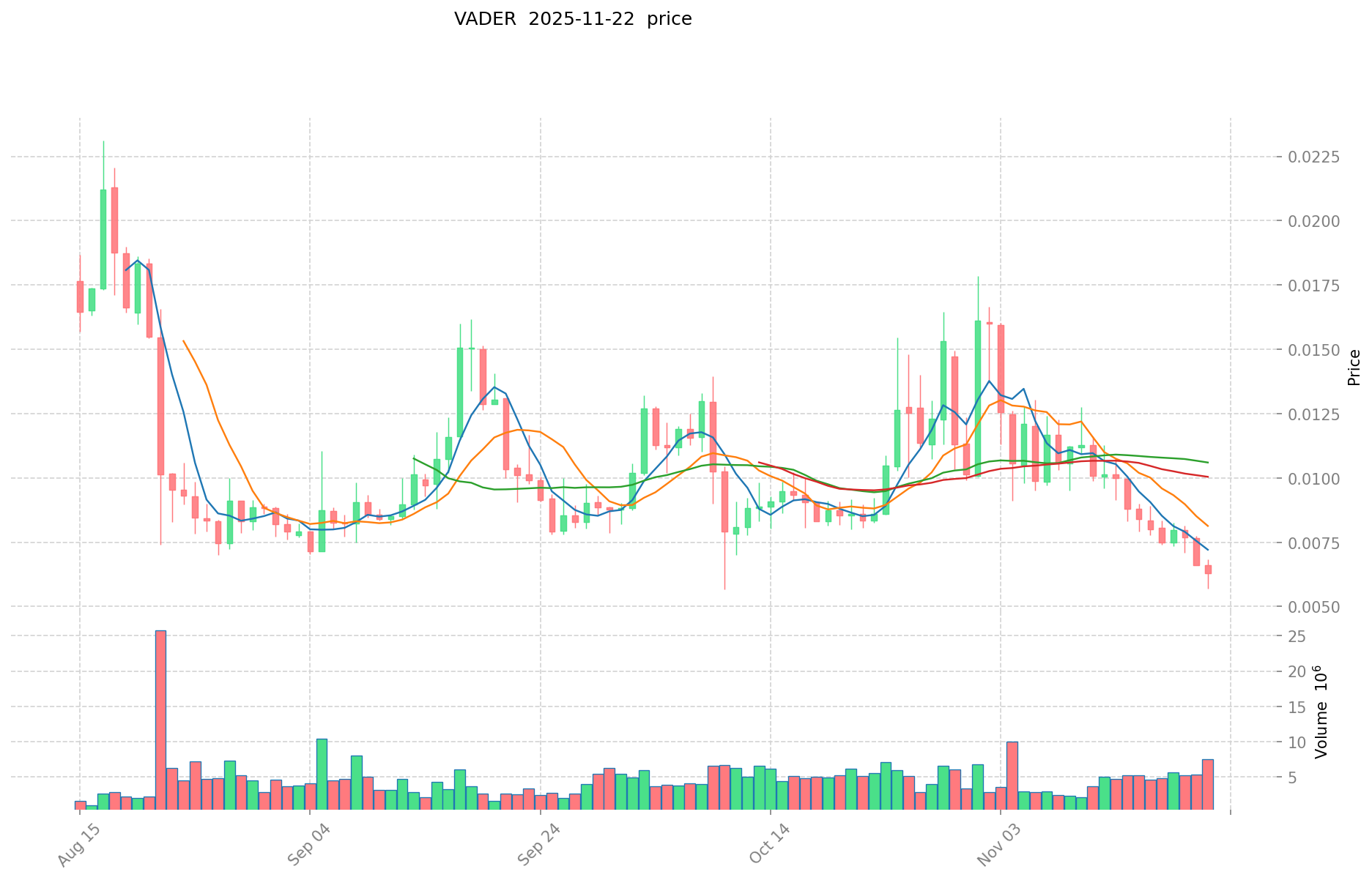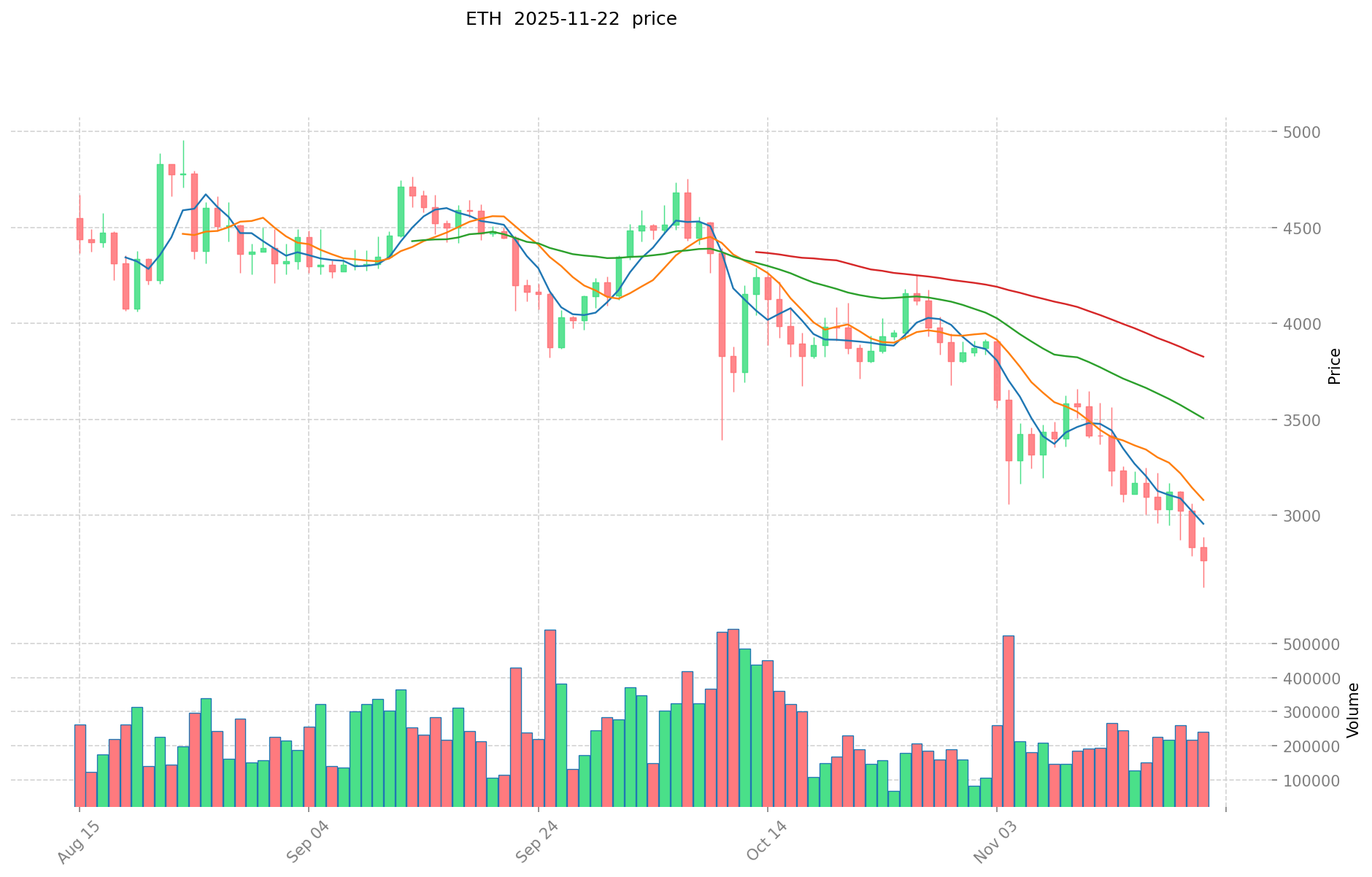VADER vs ETH: The Battle for Sentiment Analysis Supremacy in Cryptocurrency Markets
Introduction: VADER vs ETH Investment Comparison
In the cryptocurrency market, VADER vs ETH comparison is an unavoidable topic for investors. The two differ significantly in market cap ranking, application scenarios, and price performance, representing different crypto asset positioning.
VADER (VADER): Launched in 2025, it has gained market recognition for its advanced AI-driven platform designed for autonomous operation.
Ethereum (ETH): Since its inception in 2015, it has been hailed as the foundation for decentralized applications, being one of the most traded and highest market cap cryptocurrencies globally.
This article will comprehensively analyze the investment value comparison between VADER and ETH, focusing on historical price trends, supply mechanisms, institutional adoption, technical ecosystems, and future predictions, attempting to answer the question investors care about most:
"Which is the better buy right now?"
I. Price History Comparison and Current Market Status
VADER and ETH Historical Price Trends
- 2025: VADER reached its all-time high of $0.12999 on January 15, followed by a significant drop to its all-time low of $0.00491 on April 7.
- 2025: ETH hit a new all-time high of $4,946.05 on August 25, showcasing strong market performance.
- Comparative analysis: In the current market cycle, VADER has experienced extreme volatility, dropping from $0.12999 to $0.00491, while ETH has shown more stability, maintaining a price above $2,700 despite market fluctuations.
Current Market Situation (2025-11-22)
- VADER current price: $0.005951
- ETH current price: $2,766.58
- 24-hour trading volume: VADER $47,875.94 vs ETH $583,417,173.83
- Market Sentiment Index (Fear & Greed Index): 11 (Extreme Fear)
Click to view real-time prices:
- View VADER current price Market Price
- View ETH current price Market Price


II. Core Factors Affecting VADER vs ETH Investment Value
Supply Mechanism Comparison (Tokenomics)
- VADER: Fixed supply model with 25 million token cap, featuring deflationary mechanisms through token burns
- ETH: Ultra sound money model with EIP-1559 burning mechanism, creating potential deflationary pressure as network activity increases
- 📌 Historical pattern: Limited supply assets like VADER tend to experience more pronounced price volatility during bull markets, while ETH's burning mechanism ties its value more directly to network usage.
Institutional Adoption and Market Applications
- Institutional holdings: ETH has significant institutional adoption with ETFs and corporate treasury holdings, while VADER remains primarily retail-focused
- Enterprise adoption: ETH powers enterprise blockchain solutions across finance, supply chain, and Web3 infrastructure; VADER focuses on DeFi applications
- Regulatory stance: ETH benefits from regulatory clarity in most jurisdictions as a commodity, while newer tokens like VADER face greater regulatory uncertainty
Technical Development and Ecosystem Building
- ETH technical upgrades: Continued scaling improvements post-Merge with Layer 2 solutions and planned Dencun and Cancun upgrades
- VADER technical development: Building advanced DeFi mechanisms focusing on stable asset systems
- Ecosystem comparison: ETH dominates with comprehensive DeFi, NFT, gaming and enterprise applications ecosystem; VADER focuses on specialized DeFi applications with emphasis on stability mechanisms
Macroeconomic Factors and Market Cycles
- Inflation performance: Both assets can serve as inflation hedges, with ETH having a longer track record
- Monetary policy impact: Interest rate changes affect both assets, with ETH showing more correlation to traditional risk assets
- Geopolitical factors: ETH has established global adoption while VADER's smaller market cap may provide diversification benefits during market stress
III. 2025-2030 Price Prediction: VADER vs ETH
Short-term Prediction (2025)
- VADER: Conservative $0.00397 - $0.00593 | Optimistic $0.00594 - $0.00694
- ETH: Conservative $2,319 - $2,761 | Optimistic $2,762 - $3,037
Mid-term Prediction (2027)
- VADER may enter a growth phase, with prices expected in the range of $0.00449 - $0.0100
- ETH may enter a bullish market, with prices expected in the range of $2,591 - $4,456
- Key drivers: Institutional capital inflow, ETF, ecosystem development
Long-term Prediction (2030)
- VADER: Base scenario $0.00614 - $0.0120 | Optimistic scenario $0.0121 - $0.0146
- ETH: Base scenario $5,047 - $5,369 | Optimistic scenario $5,370 - $5,530
Disclaimer: The above predictions are based on historical data and market analysis. Cryptocurrency markets are highly volatile and subject to change. This information should not be considered as financial advice. Always conduct your own research before making investment decisions.
VADER:
| 年份 | 预测最高价 | 预测平均价格 | 预测最低价 | 涨跌幅 |
|---|---|---|---|---|
| 2025 | 0.0069381 | 0.00593 | 0.0039731 | 0 |
| 2026 | 0.007592179 | 0.00643405 | 0.003731749 | 8 |
| 2027 | 0.010028753735 | 0.0070131145 | 0.00448839328 | 17 |
| 2028 | 0.0126109824939 | 0.0085209341175 | 0.0054533978352 | 43 |
| 2029 | 0.013524426631296 | 0.0105659583057 | 0.00845276664456 | 77 |
| 2030 | 0.014574682886882 | 0.012045192468498 | 0.006143048158933 | 102 |
ETH:
| 年份 | 预测最高价 | 预测平均价格 | 预测最低价 | 涨跌幅 |
|---|---|---|---|---|
| 2025 | 3037.243 | 2761.13 | 2319.3492 | 0 |
| 2026 | 3421.04007 | 2899.1865 | 2029.43055 | 4 |
| 2027 | 4455.75973185 | 3160.113285 | 2591.2928937 | 14 |
| 2028 | 5369.19047687925 | 3807.936508425 | 2246.68253997075 | 37 |
| 2029 | 6148.6750801538475 | 4588.563492652125 | 2523.70992095866875 | 65 |
| 2030 | 5529.677864995075837 | 5368.61928640298625 | 5046.502129218807075 | 94 |
IV. Investment Strategy Comparison: VADER vs ETH
Long-term vs Short-term Investment Strategies
- VADER: Suitable for investors focused on DeFi innovations and growth potential
- ETH: Suitable for investors seeking stability, ecosystem strength, and inflation resistance
Risk Management and Asset Allocation
- Conservative investors: VADER: 10% vs ETH: 90%
- Aggressive investors: VADER: 30% vs ETH: 70%
- Hedging tools: Stablecoin allocation, options, cross-currency portfolios
V. Potential Risk Comparison
Market Risks
- VADER: High volatility, limited market history, potential for extreme price swings
- ETH: Correlation with broader crypto market, susceptibility to macro-economic factors
Technical Risks
- VADER: Scalability, network stability, smart contract vulnerabilities
- ETH: Network congestion, gas fee fluctuations, potential security exploits
Regulatory Risks
- Global regulatory policies may have differing impacts on both assets, with ETH potentially facing less regulatory uncertainty due to its established status
VI. Conclusion: Which Is the Better Buy?
📌 Investment Value Summary:
- VADER advantages: Innovative AI-driven platform, fixed supply model, potential for high growth
- ETH advantages: Established ecosystem, institutional adoption, ongoing technical improvements
✅ Investment Advice:
- New investors: Focus on ETH for its established track record and lower volatility
- Experienced investors: Consider a balanced portfolio with both ETH and a small allocation to VADER
- Institutional investors: Prioritize ETH for its liquidity and regulatory clarity, with potential small exposure to VADER for diversification
⚠️ Risk Warning: The cryptocurrency market is highly volatile. This article does not constitute investment advice. None
VII. FAQ
Q1: What are the key differences between VADER and ETH in terms of investment potential? A: VADER is a newer cryptocurrency with a fixed supply model and AI-driven platform, offering potentially higher growth but with increased volatility. ETH is a more established asset with a large ecosystem, institutional adoption, and ongoing technical improvements, providing greater stability and liquidity.
Q2: How do the supply mechanisms of VADER and ETH compare? A: VADER has a fixed supply cap of 25 million tokens with deflationary mechanisms through token burns. ETH follows an "ultra sound money" model with the EIP-1559 burning mechanism, creating potential deflationary pressure as network activity increases.
Q3: Which cryptocurrency has better institutional adoption? A: ETH has significant institutional adoption with ETFs and corporate treasury holdings, while VADER remains primarily retail-focused. ETH also powers enterprise blockchain solutions across various industries, whereas VADER focuses mainly on DeFi applications.
Q4: What are the price predictions for VADER and ETH by 2030? A: For VADER, the base scenario predicts $0.00614 - $0.0120, with an optimistic scenario of $0.0121 - $0.0146. For ETH, the base scenario predicts $5,047 - $5,369, with an optimistic scenario of $5,370 - $5,530. However, these predictions are subject to market volatility and should not be considered financial advice.
Q5: How should investors allocate their portfolio between VADER and ETH? A: Conservative investors might consider allocating 10% to VADER and 90% to ETH, while more aggressive investors could allocate 30% to VADER and 70% to ETH. The exact allocation should depend on individual risk tolerance and investment goals.
Q6: What are the main risks associated with investing in VADER and ETH? A: VADER risks include high volatility, limited market history, and potential technical vulnerabilities. ETH risks involve correlation with the broader crypto market, network congestion, and gas fee fluctuations. Both face regulatory risks, although ETH may have less uncertainty due to its established status.
Q7: Which cryptocurrency is better suited for new investors? A: New investors are generally advised to focus on ETH due to its established track record, lower volatility, and broader ecosystem. ETH offers a more stable entry point into the cryptocurrency market compared to the newer and more volatile VADER.
Share
Content